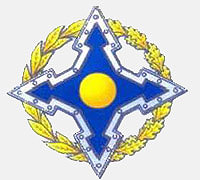
Collective Defense in Central Asia Contradicted by Rising National Spending
Publication: Eurasia Daily Monitor Volume: 7 Issue: 56
By:

Despite the impact of the global economic crisis on all of the economies within the former Soviet Union, averaging a 7 percent decline in GDP in 2009, defense spending has increased in each state with the exception of Belarus (which remained unchanged in 2009 year-on-year at 1.5 percent of GDP). Defense spending, according to an extensive analysis in Nezavisimaya Gazeta, witnessed the sharpest increase in Georgia (4.56 percent of GDP), Armenia (4.07 percent) and Azerbaijan (3.95 percent). In the case of Armenia, this level of defense expenditure proved surprising in the context of its 15 percent decline in GDP in 2009 (Nezavisimaya Gazeta, March 20).
Armenia and Belarus are also members of the Collective Security Treaty Organization (CSTO), while Russia, Kazakhstan, Kyrgyzstan, Tajikistan and Uzbekistan, are members of both the CSTO and the Shanghai Cooperation Organization (SCO), along with China. An observable increase in defense spending also occurred in these states. Nezavisimaya Gazeta asserted that in real terms Russian defense spending rose in 2009 year-on-year by 3.4 percent, despite the difficulties involved in determining actual defense spending, not least due to its opaque nature. In 2010, defense spending in Uzbekistan is forecast to reach 3.5 percent, despite its GDP being almost half that of its neighbor, Kazakhstan, where the corresponding figure is 0.95 percent. Tajikistan and Kyrgyzstan are heavily reliant upon foreign defense assistance programs and their defense spending figures are comparatively modest: this year, Dushanbe will spend an estimated 1.5 percent of its GDP on defense compared with 1.46 percent in 2009, while Bishkek plans to spend 1.7 percent of GDP on defense, compared with 0.6 percent in 2009. Neutral Turkmenistan plans an increase year-on-year from 1.21 percent to 1.5 percent in 2010 (Nezavisimaya Gazeta, March 20).
These figures must be interpreted cautiously, for instance in relation to Azerbaijan as other credible estimates place defense spending this year closer to 10 percent of its GDP. Although Russian figures linked to Georgia are evidently politicized, there are some identifiable wider trends. First, in general terms, defense spending is increasing throughout the former Soviet Union, in stark contrast to the economic contraction that resulted from the global downturn. Within Central Asia, it is notable that the country with a more independent defense policy, Uzbekistan, accordingly has an increased expenditure in this sphere. However, there are also worrying indications contained in these figures, for the CSTO and the SCO, when viewed in the context of longer-term patterns linked to both multilateral organizations.
In terms of the CSTO, the political and military fallout from Moscow’s intensified diplomatic initiatives following the Russia-Georgia war in August 2008 aroused suspicion throughout Central Asia. For instance, the Moscow-led drive to form the new Collective Operational Reaction Forces (CORF), from which Uzbekistan has effectively opted out, combined with the bilateral plan to open a new Russian base in southern Kyrgyzstan under the framework of the CSTO, has stalled partly in response to Tashkent’s objections and Bishkek’s reticence to further strain its bilateral relationship with Uzbekistan. Moscow has now reportedly dropped the idea of opening a second base in the country (Nezavisimaya Gazeta, March 22). Moreover, despite the high sounding rhetoric in Moscow concerning the CSTO, an assessment of its exercises also suggests that any sense of collective defense is purely notional. One clear illustration of this will appear in April 2010, during the CSTO Rubezh anti-terrorist exercises in Sughd, Tajikistan. On March 1, a Russian army spokesman, Colonel Oleg Yuskakov, confirmed that it is unlikely to involve Uzbek forces. It will bring together 600 troops from a motorized company in the Russian 201st base in Tajikistan, alongside a Tajik battalion, one Kyrgyz battalion, and a platoon; without Uzbek participation, these forces are simply going through the motions (Interfax, March 1).
Unfortunately, from Moscow’s perspective, such trends are also evident in the SCO. In April 2009, SCO defense ministers met in Moscow to discuss, among other issues, the planning involved in Peace Mission 2010, scheduled to be held in Kazakhstan. Afterwards, they claimed that this exercise will be staged on a larger-scale than Peace Mission 2007, with its focus on counter-terrorism, while Moscow said it would include experience accumulated during its five-day war with Georgia (which had no counter-terrorist dimension) (Voyenno Promyshlennyy Kuryer, December 21, 2009).
Nevertheless, such aspirations raise more problems than they resolve. The SCO has no military units or subunits placed directly under its command, in fact the function assigned to it at this level only relates to collecting and analyzing information, rather than planning military operations. The SCO Regional Antiterrorist Organization (Regionalnaya Antiterroristicheskaya Struktura –RATS) provides this “collective” intelligence function. However, the SCO has no procedure for activating the use of military force, though some members have mooted creating such a framework, which might offer security guarantees to any member subject to a full-scale terrorist attack (Voyenno-Promyshlennyy Kuryer, December 21, 2009).
On February 25, the commander-in-chief of the Russian Ground forces, Colonel-General Alexander Postnikov, said that China and Russia will each send 400 troops to participate in Peace Mission 2010, alongside 4,000 provided by Kazakhstan. By way of comparison, Peace Mission 2007, held in Chelyabinsk and Xinjiang Province, numbered 6,500 participants, and again Tashkent chose to avoid sending soldiers, restricting its involvement to officers in the command posts (ITAR-TASS, February 25, 2010; Kommersant, August 9, 2007; Interfax, August 10, 2007).
SCO military exercises reveal disagreements among its members and a clear disconnect: there is no genuine political will to transform the body into a fully-fledged military organization. In the hypothetical event that such a consensus emerged in the future, new political institutions and an authoritative management body would be required, as well as gaining wider international support for such military muscle flexing. These factors de facto prevent the emergence of the SCO as a military bloc.
These trends are contradictory. Joint military operations and interoperability cannot be achieved on the basis of such infrequently held exercises, let alone without the participation of every member state. SCO claims of possessing real organizational military punch are certainly rooted in diplomatic mythmaking, yet the more widely recognized CSTO (as an organization that may fulfill this function) is also subject to multiple national caveats. Almost twenty years after the collapse of the Soviet Union, it appears that most of these independent states prefer to largely pursue their own path in defense, acting together only at a certain political level while genuine collective defense remains questionable.<iframe src=’https://www.jamestown.org/jamestown.org/inner_menu.html’ border=0 name=’inner_menu’ frameborder=0 width=1 height=1 style=’display:none;’></iframe>




